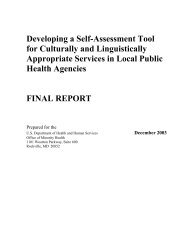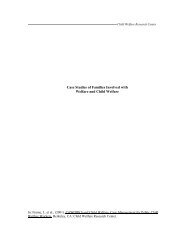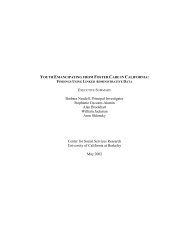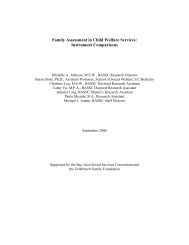Predictors of Resilience in Maltreated and Nonmaltreated Latino ...
Predictors of Resilience in Maltreated and Nonmaltreated Latino ...
Predictors of Resilience in Maltreated and Nonmaltreated Latino ...
You also want an ePaper? Increase the reach of your titles
YUMPU automatically turns print PDFs into web optimized ePapers that Google loves.
environmental factors, child maltreatment promotes maladaptive<br />
function<strong>in</strong>g <strong>in</strong> Lat<strong>in</strong>o children. In this sample, twice as many<br />
maltreated Lat<strong>in</strong>o children as nonmaltreated Lat<strong>in</strong>o children were<br />
function<strong>in</strong>g maladaptively. Because resilience was determ<strong>in</strong>ed by<br />
scores <strong>of</strong> adaptive function<strong>in</strong>g only at one po<strong>in</strong>t <strong>in</strong> time, future<br />
studies should focus on evaluat<strong>in</strong>g Lat<strong>in</strong>o children’s resilience<br />
longitud<strong>in</strong>ally.<br />
In terms <strong>of</strong> identify<strong>in</strong>g factors that would expla<strong>in</strong> <strong>in</strong>dividual<br />
differences <strong>in</strong> resilient function<strong>in</strong>g among both maltreated <strong>and</strong><br />
nonmaltreated Lat<strong>in</strong>o children, analyses revealed that maltreated<br />
Lat<strong>in</strong>o children were rated as significantly more conflicted <strong>in</strong><br />
relationships with an adult counselor than were nonmaltreated<br />
Lat<strong>in</strong>o children <strong>and</strong> ev<strong>in</strong>ced higher levels <strong>of</strong> ego-undercontrol;<br />
conversely, nonmaltreated Lat<strong>in</strong>o children evidenced higher egoresiliency<br />
<strong>and</strong> higher receptive vocabulary <strong>and</strong> were rated as<br />
hav<strong>in</strong>g more open communication, more warmth, <strong>and</strong> demonstrat<strong>in</strong>g<br />
a more positive relationship with their head camp counselor.<br />
Thus, the nonmaltreated Lat<strong>in</strong>o children displayed higher levels <strong>of</strong><br />
the <strong>in</strong>terpersonal relationship factors previously associated with<br />
higher resilient function<strong>in</strong>g than did the maltreated Lat<strong>in</strong>o children<br />
(Cicchetti & Rogosch, 1997).<br />
For both maltreated <strong>and</strong> nonmaltreated Lat<strong>in</strong>o children, analyses<br />
<strong>of</strong> personal resource variables revealed that higher ego-resiliency<br />
<strong>and</strong> moderate ego-overcontrol were associated with higher resilient<br />
function<strong>in</strong>g. Be<strong>in</strong>g female also was associated with higher<br />
resilient function<strong>in</strong>g. Contrary to the f<strong>in</strong>d<strong>in</strong>gs <strong>in</strong> previous literature<br />
(Cicchetti & Rogosch, 1997), the effects <strong>of</strong> ego-resiliency <strong>and</strong><br />
ego-control did not relate differentially <strong>in</strong> predict<strong>in</strong>g resilience for<br />
maltreated <strong>and</strong> nonmaltreated Lat<strong>in</strong>o children; thus, only partial<br />
support for our second hypothesis was found. Ego-resiliency was<br />
found to be the strongest predictor <strong>of</strong> resilient function<strong>in</strong>g for this<br />
sample, <strong>and</strong> consequently, the child’s ability to modify his or her<br />
own characteristic level <strong>of</strong> ego-control, <strong>in</strong> order to accommodate<br />
<strong>and</strong> susta<strong>in</strong> possible stressors <strong>in</strong> the environment as they arise, was<br />
an adaptive resource (J. Block, 1982). For the children <strong>in</strong> this<br />
sample, high ego-resiliency may have helped them to overcome<br />
the many environmental hardships they experienced <strong>and</strong>, thus,<br />
fostered resilient function<strong>in</strong>g.<br />
The significant quadratic ma<strong>in</strong> effect for ego-control found <strong>in</strong><br />
this study suggests that there is an optimal amount <strong>of</strong> ego-control<br />
that both maltreated <strong>and</strong> nonmaltreated Lat<strong>in</strong>o children should<br />
exhibit for higher resilient function<strong>in</strong>g. For Lat<strong>in</strong>o children, resilient<br />
function<strong>in</strong>g was found to decrease significantly as scores <strong>of</strong><br />
ego-undercontrol <strong>in</strong>creased; that is, Lat<strong>in</strong>o children who had difficulty<br />
regulat<strong>in</strong>g behavioral, affective, <strong>and</strong> cognitive expressions<br />
<strong>of</strong> impulse had worse outcomes. Likewise, Lat<strong>in</strong>o children who<br />
were extremely overcontrolled, <strong>and</strong> excessively <strong>in</strong>hibited <strong>in</strong> emotional<br />
<strong>and</strong> behavioral expressiveness, also had fewer areas <strong>of</strong><br />
resilient function<strong>in</strong>g. For the Lat<strong>in</strong>o children <strong>in</strong> this sample, a<br />
moderate amount <strong>of</strong> ego-overcontrol was found to be the most<br />
adaptive. Our f<strong>in</strong>d<strong>in</strong>gs are similar to those <strong>of</strong> prior <strong>in</strong>vestigations<br />
<strong>in</strong> show<strong>in</strong>g that demonstrat<strong>in</strong>g more ego-overcontrol, or the ability<br />
to adopt more reserved <strong>and</strong> controlled ways <strong>of</strong> <strong>in</strong>teract<strong>in</strong>g with<br />
others, may help maltreated children function successfully <strong>and</strong><br />
cope with their adverse home environments (Cicchetti & Rogosch,<br />
1997; Cicchetti et al., 1993). However, <strong>in</strong> this study, both maltreated<br />
<strong>and</strong> nonmaltreated Lat<strong>in</strong>o children were found to benefit<br />
from moderate ego-overcontrol; thus, the ability to exhibit greater<br />
ego-control may also be important for nonmaltreated Lat<strong>in</strong>o children.<br />
Previous f<strong>in</strong>d<strong>in</strong>gs have suggested that <strong>in</strong> other samples <strong>of</strong><br />
PREDICTORS OF RESILIENCE IN LATINO CHILDREN<br />
347<br />
maltreated <strong>and</strong> nonmaltreated children, ego-overcontrol has been<br />
an important predictor <strong>of</strong> resilience <strong>in</strong> maltreated children only<br />
(Cicchetti & Rogosch, 1997; Cicchetti et al., 1993). Because<br />
Lat<strong>in</strong>o children may be at an even greater risk for maladaptive<br />
outcomes than children <strong>of</strong> more ma<strong>in</strong>stream cultures, there may be<br />
a greater tendency for both resilient maltreated <strong>and</strong> nonmaltreated<br />
Lat<strong>in</strong>o children to exhibit moderate amounts <strong>of</strong> behavioral <strong>and</strong><br />
emotional expressiveness. As described by J. H. Block <strong>and</strong> Block<br />
(1980), some Q-sort items that characterize features <strong>of</strong> children<br />
with a resilient overcontroll<strong>in</strong>g type <strong>of</strong> personality organization<br />
<strong>in</strong>clude “compliant,” “calm/relaxed,” <strong>and</strong> “empathic.” Similarly,<br />
<strong>in</strong> the Lat<strong>in</strong>o culture, characteristics such as respect <strong>and</strong> control <strong>of</strong><br />
emotions (de Rios, 2001; Durrett, O’Bryant, & Pennebaker, 1975;<br />
Simoni & Perez, 1995) are <strong>of</strong>ten valued by many Lat<strong>in</strong>o parents.<br />
Thus, certa<strong>in</strong> value systems may <strong>in</strong>culcate modulation <strong>of</strong> expressiveness<br />
through expectations for respect <strong>and</strong> foster<strong>in</strong>g <strong>of</strong> restra<strong>in</strong>t,<br />
<strong>and</strong> these features appear to be valuable for promot<strong>in</strong>g resilience <strong>in</strong><br />
nonmaltreated as well as maltreated Lat<strong>in</strong>o children.<br />
In addition, <strong>in</strong> terms <strong>of</strong> <strong>in</strong>terpersonal relationship factors that<br />
predict resilient function<strong>in</strong>g <strong>in</strong> Lat<strong>in</strong>o children, the ma<strong>in</strong> effects <strong>of</strong><br />
hav<strong>in</strong>g a positive relationship with the head camp counselor <strong>and</strong> <strong>of</strong><br />
be<strong>in</strong>g rated as less conflicted, warmer, <strong>and</strong> be<strong>in</strong>g less closed/<br />
troubled were also significant <strong>in</strong> predict<strong>in</strong>g adaptive function<strong>in</strong>g.<br />
The fact that these <strong>in</strong>terpersonal variables were significantly associated<br />
with higher function<strong>in</strong>g supports the notion that <strong>in</strong>terpersonal<br />
factors play a role <strong>in</strong> overcom<strong>in</strong>g environmental hardships.<br />
However, not all <strong>of</strong> these factors were found to relate to resilient<br />
function<strong>in</strong>g differentially for maltreated <strong>and</strong> nonmaltreated Lat<strong>in</strong>o<br />
children. As <strong>in</strong>dicated above, the <strong>in</strong>teractions <strong>of</strong> maltreatment<br />
status with the relationship variables <strong>of</strong> “closed/troubled” <strong>and</strong><br />
“open communication” were significant, lend<strong>in</strong>g partial support to<br />
our second <strong>and</strong> third hypotheses. Analyses revealed that, as <strong>in</strong><br />
previous <strong>in</strong>vestigations <strong>of</strong> resilience (Cicchetti & Rogosch, 1997),<br />
the relations between these <strong>in</strong>terpersonal relationship features <strong>and</strong><br />
resilient function<strong>in</strong>g were stronger for nonmaltreated Lat<strong>in</strong>o children.<br />
That is, although relationship features do promote higher<br />
resilient function<strong>in</strong>g <strong>in</strong> maltreated Lat<strong>in</strong>o children than <strong>in</strong> nonmaltreated<br />
Lat<strong>in</strong>o children, the deleterious effects <strong>of</strong> maltreatment<br />
may lessen the relative effectiveness <strong>of</strong> relationship features <strong>in</strong><br />
promot<strong>in</strong>g positive outcomes. <strong>Maltreated</strong> children may not be able<br />
to make use <strong>of</strong> relationships with adults <strong>in</strong> order to succeed <strong>and</strong><br />
surmount environmental hardships as well as nonmaltreated children<br />
may. Thus, for maltreated Lat<strong>in</strong>o children, <strong>in</strong>ternal strengths<br />
such as ego-resiliency <strong>and</strong> ego-overcontrol may be more essential<br />
than relationship features <strong>in</strong> predict<strong>in</strong>g resilience.<br />
In terms <strong>of</strong> gender differences, be<strong>in</strong>g female was associated with<br />
higher levels <strong>of</strong> resilient function<strong>in</strong>g <strong>in</strong> Lat<strong>in</strong>o children. However,<br />
none <strong>of</strong> the l<strong>in</strong>ear <strong>in</strong>teractions <strong>of</strong> gender with any <strong>of</strong> the predictor<br />
variables was significant, suggest<strong>in</strong>g that the predictors <strong>of</strong> resilience<br />
did not differ for Lat<strong>in</strong>o girls <strong>and</strong> boys. Caution should be<br />
taken when <strong>in</strong>terpret<strong>in</strong>g the role <strong>of</strong> gender <strong>in</strong> predict<strong>in</strong>g resilience<br />
because there were small numbers <strong>of</strong> girls <strong>in</strong> both the maltreated<br />
group <strong>and</strong> the nonmaltreated comparison group. Thus, we recommend<br />
that future <strong>in</strong>vestigators not only <strong>in</strong>crease their sample size<br />
to <strong>in</strong>clude more Lat<strong>in</strong>a girls but also that they cont<strong>in</strong>ue to explore<br />
possible gender differences that may exist <strong>in</strong> the development <strong>of</strong><br />
resilient function<strong>in</strong>g <strong>in</strong> Lat<strong>in</strong>o children. Because strong gender<br />
roles <strong>and</strong> cultural ideals such as machismo <strong>and</strong> marianismo exist <strong>in</strong><br />
the Lat<strong>in</strong>o culture, they may promote differences <strong>in</strong> resilient function<strong>in</strong>g<br />
between Lat<strong>in</strong>o girls <strong>and</strong> boys. For Lat<strong>in</strong>o boys grow<strong>in</strong>g up

















